Subtitle: “Your Comprehensive Guide to ZZ Plant Care, Propagation, Soil, Fertilizer, Light, Pests, Pruning, Repotting, Water, and Humidity”
Introduction: Unlock the Secrets of ZZ Plant Magic
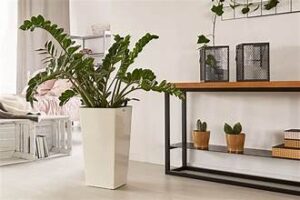
Welcome, plant enthusiasts, to the enchanting world of ZZ plants! If you’re already acquainted with these resilient and captivating indoor companions, you know just how magical they can be. And if you’re new to the realm of ZZ plants, get ready to embark on a journey filled with lush, healthy growth and a touch of green enchantment.
In our previous article, “Green Thumbs Unite: Discovering the Best Indoor Plants for Every Home,” we unveiled the top 10 favorite house plants that have found a place in the hearts and homes of plant lovers everywhere. Among this illustrious list, the ZZ plant stood tall as a symbol of resilience and elegance, earning its well-deserved spot as a cherished favorite.
If you missed the listicle, fear not! You can catch up on our selection of top indoor plants by visiting TrustedHouseplantGuide.com. Once you’re acquainted with the stars of indoor gardening, return here to delve deep into the secrets of ZZ plant care and discover how to nurture these green wonders to perfection.
Join us on this journey as we unlock the magic of ZZ plants, revealing easy steps to ensure they thrive, grow lush and healthy, and add a touch of natural elegance to your indoor spaces.
Section 1: ZZ Plant Care Basics
ZZ plants, also known as Zamioculcas zamiifolia, have gained a reputation for being incredibly resilient and low-maintenance indoor companions. Whether you’re a seasoned plant enthusiast or just starting your green journey, understanding the basics of ZZ plant care is essential for ensuring their vitality and longevity.
ZZ Plant Care Essentials:
Light: ZZ plants are versatile and can tolerate various lighting conditions, but they truly thrive in bright, indirect light. They can even adapt to low light environments, making them suitable for homes or offices with limited natural light. When placing your ZZ plant, aim for a spot where it receives consistent but indirect sunlight. Avoid exposing it to harsh, direct sunlight as this can lead to leaf scorching.
Watering: ZZ plants are forgiving when it comes to watering, and their motto seems to be “dry before you try.” These hardy plants prefer to dry out slightly between watering sessions. To determine when it’s time to water, simply insert your finger into the soil. If the top inch (2.5 cm) feels dry, it’s time to water. Remember that ZZ plants are more tolerant of underwatering than overwatering, so it’s better to be cautious with watering frequency.
Temperature: ZZ plants prefer a temperature range between 65°F to 75°F (18°C to 24°C). They can withstand occasional drops in temperature but should be shielded from frost. Keep them away from drafty windows or doors during the colder months.
Soil and Potting: Well-draining soil is crucial for ZZ plants. They dislike sitting in waterlogged soil, so it’s essential to use a pot with a drainage hole to prevent water accumulation at the root level. A suitable potting mix can consist of regular potting soil mixed with perlite or cactus mix to enhance drainage.
Patience and Growth: ZZ plants are slow growers, but they reward your patience with steady and attractive growth. Don’t be discouraged by their gradual progress; it’s all part of their charm.
By mastering these ZZ plant care basics, you’re well on your way to nurturing a thriving and resilient indoor green companion. In the following sections, we’ll explore more aspects of ZZ plant care, including light requirements, watering, humidity, soil and repotting, fertilization, propagation, pruning, and pest management. So, let’s continue our journey into the world of ZZ plant magic.
Section 2: ZZ Plant Light Requirements
For your ZZ plant to thrive, understanding its specific ZZ plant light requirements is crucial. These resilient indoor beauties are known for their adaptability to various lighting conditions, making them a popular choice for homes and offices alike.
Optimal Light Conditions: ZZ plants are at their best when placed in bright, indirect light. This means they should receive a consistent but gentle stream of sunlight, preferably without the direct rays. Think of them as your indoor green companions that love a sunny room without having to stand in the blazing sun. However, they are adaptable and can survive in lower light conditions as well, making them suitable for areas with limited natural light.
Placement Matters: To ensure your ZZ plant receives the right amount of light, strategically place it near a window with filtered sunlight. East or west-facing windows are often ideal, as they provide the right balance of brightness without exposing the plant to intense, scorching rays. If you have a south-facing window, consider moving your ZZ plant slightly away from the window to prevent excessive light exposure.
Watch Out for Overhead Lighting: ZZ plants are sensitive to direct overhead lighting, such as strong ceiling lights or fluorescent fixtures. These can be too intense for your plant and may lead to leaf burn. Be mindful of your ZZ plant’s placement in rooms with intense artificial lighting.
Low Light Tolerance: What makes ZZ plants truly remarkable is their ability to adapt to low light conditions. While they may not grow as quickly or produce as many new shoots in low light, they will survive and remain healthy. This trait makes ZZ plants versatile and suitable for spaces with minimal natural light.
Signs of Light Stress: Pay attention to your ZZ plant’s leaves. If they start to turn yellow or brown, it may be a sign of too much direct light. Conversely, if the stems become long and leggy with widely spaced leaves, it might indicate insufficient light. Adjust the placement accordingly to keep your ZZ plant happy.
In the world of indoor plants, ZZ plants are champions when it comes to light adaptability. By providing them with the right amount of bright, indirect light, you’ll create the perfect environment for your ZZ plant to flourish. Next, we’ll explore another critical aspect of ZZ plant care: watering and humidity.
Section 3: ZZ Plant Watering and Humidity 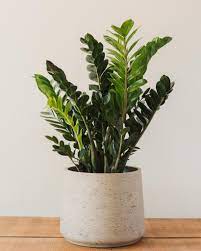
In the world of indoor gardening, achieving the perfect balance of ZZ plant watering and humidity is the key to ensuring your ZZ plant thrives and remains lush. ZZ plants are known for their hardiness, but understanding their specific moisture needs is essential for long-term health.
Ideal Watering Schedule: ZZ plants have a straightforward rule when it comes to watering – “dry before you try.” These hardy plants prefer to dry out slightly between watering sessions. To determine when it’s time to water, insert your finger about an inch (2.5 cm) into the soil. If it feels dry to the touch, it’s time to water. However, if it still feels slightly moist, it’s best to wait a bit longer before watering again.
Underwatering vs. Overwatering: ZZ plants are more tolerant of underwatering than overwatering. They can survive periods of neglect, but consistently overwatering can lead to root rot and other issues. Err on the side of caution when it comes to watering frequency, and remember that it’s better to let the soil dry out a bit too much than to keep it consistently soggy.
Watering Technique: When it’s time to water, do so thoroughly but avoid letting the ZZ plant sit in standing water. Water the plant until you see excess water draining out of the pot’s drainage hole. Empty the saucer beneath the pot to prevent water accumulation.
Humidity Requirements: ZZ plants are not particularly fussy about humidity levels, and they can adapt to a wide range of indoor humidity conditions. However, maintaining moderate humidity can be beneficial for their overall well-being. If you live in a very dry climate or have your ZZ plant in a room with low humidity, consider these steps:
-
- Grouping indoor plants together can create a microclimate with slightly higher humidity.
-
- Occasionally misting your ZZ plant’s leaves with water can help increase humidity locally.
-
- Placing a humidity tray filled with water and pebbles near the plant can provide added moisture in the vicinity.
For those of you with super busy schedules or newcomers to the house plant community, there are several handy watering aids available to simplify the process. Here’s a list of some great watering aids, along with their approximate prices and where to purchase them online:
| Name | Approximate Price | Online Purchase |
| Self-Watering Planters | $15 – $50 | Link to Purchase |
| Plant Watering Spikes | $5 – $15 | Link to Purchase |
| Hydrogel Crystals | $5 – $10 | Link to Purchase |
| Smart Plant Sensors | $20 – $50 | Link to Purchase |
| Capillary Matting | $15 – $30 | Link to Purchase |
By incorporating these watering aids into your ZZ plant care routine, you can ensure that your ZZ plant receives the right amount of moisture even during your busiest days. Next, let’s explore another critical aspect of ZZ plant care: soil and repotting.
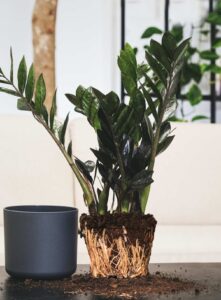
Section 4: ZZ Plant Soil and Repotting
Proper soil and repotting practices are essential elements of ZZ plant care that contribute to the long-term health and vitality of your green companion. ZZ plants thrive when provided with the right soil, and occasional repotting ensures they have adequate space for growth. Here’s how to choose the right soil and when to repot, along with some recommended soil products:
Choosing the Right Soil: ZZ plants require well-draining soil to prevent waterlogging, which can lead to root rot. You can create a suitable potting mix by combining regular potting soil with perlite or cactus mix. This blend ensures adequate drainage, allowing excess water to escape the root zone.
Recommended Soil Products:
-
- Price: $10 – $15 for a 4-quart bag
- Key Characteristics: Specifically formulated for cacti and succulents, well-draining, enriched with Myco-tone for root growth.
-
- Points of Purchase: Available at local garden centers and online retailers.
- Price: $10 – $15 for a 4-quart bag
-
- Price: $8 – $12 for an 8-quart bag
- Key Characteristics: Promotes root development, pH balanced for cacti and succulents, free from harmful chemicals.
-
- Points of Purchase: Found at local garden centers and online.
- Price: $8 – $12 for an 8-quart bag
-
- Price: $5 – $10 for an 8-quart bag
- Key Characteristics: Enriched with essential nutrients, fast-draining formula, suitable for various arid plants.
-
- Points of Purchase: Available at local garden centers and online.
- Price: $5 – $10 for an 8-quart bag
-
- Price: $10 – $15 for an 8-quart bag
- Key Characteristics: Well-draining, includes pumice and perlite, pH balanced for succulents.
-
- Points of Purchase: Found at local garden centers and online retailers.
- Price: $10 – $15 for an 8-quart bag
-
- Price: $12 – $18 for an 8-quart bag
- Key Characteristics: Lightweight, porous mix, enriched with earthworm castings, ideal for succulents.
-
- Points of Purchase: Available at local garden centers and online.
- Price: $12 – $18 for an 8-quart bag
Repotting ZZ Plants: ZZ plants are known for their slow growth, and they don’t require frequent repotting. However, repotting becomes necessary when the plant outgrows its current container, or the soil becomes depleted of nutrients. Here are some signs that indicate it’s time to repot your ZZ plant:
-
- The plant has visibly outgrown its pot, with roots becoming crowded.
-
- The plant is not thriving, despite appropriate care, indicating nutrient depletion in the soil.
-
- The potting mix has become compacted and doesn’t drain properly.
When repotting your ZZ plant, follow these steps:
-
- Choose a slightly larger pot with good drainage.
-
- Gently remove the ZZ plant from its current pot.
-
- Shake off excess soil from the roots.
-
- Place fresh potting mix at the bottom of the new pot.
-
- Position the ZZ plant in the center and fill in with more potting mix.
-
- Water thoroughly after repotting.
It’s essential to repot your ZZ plant during its active growing season, which is typically spring or early summer. Repotting too frequently or during the dormant period can stress the plant.
By providing the right soil and occasionally repotting your ZZ plant when needed, you ensure that it has ample space and nutrients to continue thriving. In the next section, we’ll delve into another vital aspect of ZZ plant care: fertilization.
Section 5: ZZ Plant Fertilization
ZZ plant fertilization is crucial for maintaining the lush green foliage and overall health of your plant. While ZZ plants are generally low-maintenance, they benefit from occasional feeding to ensure they have the necessary nutrients for growth. Here’s what you need to know:
When to Fertilize: ZZ plants have a slow growth rate and don’t require frequent fertilization. During the growing season, which typically spans from spring to early autumn, you can fertilize your ZZ plant once a month. However, during the dormant winter months, it’s best to skip fertilization as the plant’s growth slows down.
Choosing the Right Fertilizer: When selecting a fertilizer for your ZZ plant, opt for a balanced, water-soluble fertilizer with a formulation like 20-20-20 or 10-10-10. These numbers represent the percentages of nitrogen (N), phosphorus (P), and potassium (K) in the fertilizer. The balanced formula ensures your ZZ plant receives a well-rounded mix of essential nutrients.
Application Method: Dilute the fertilizer according to the manufacturer’s instructions, typically at half the recommended strength. Water your ZZ plant with the diluted fertilizer solution during its regular watering. Ensure that the soil is moist but not waterlogged before applying fertilizer.
Fertilization Tips:
-
- Always follow the recommended dosage instructions on the fertilizer packaging to avoid over-fertilizing, which can harm the plant.
-
- Avoid fertilizing a dry ZZ plant, as it can lead to root burn. Ensure the soil is consistently moist before applying fertilizer.
-
- Flush the soil with plain water every few months to prevent fertilizer salt buildup in the potting mix.
Recommended Fertilizer Products:
-
- Price: $5 – $10 for an 8-ounce bottle
- Key Characteristics: Balanced N-P-K ratio, easy-to-use liquid formula, suitable for a wide range of indoor plants.
-
- Points of Purchase: Available at local garden centers and online.
- Price: $5 – $10 for an 8-ounce bottle
-
- Price: $7 – $12 for a 4-ounce bottle
- Key Characteristics: Balanced formula, promotes lush growth, convenient liquid concentrate.
-
- Points of Purchase: Found at local garden centers and online retailers.
- Price: $7 – $12 for a 4-ounce bottle
-
- Price: $8 – $15 for an 8-ounce bottle
- Key Characteristics: Organic and environmentally friendly, safe for pets, gentle on plants.
-
- Points of Purchase: Available at local garden centers and online.
- Price: $8 – $15 for an 8-ounce bottle
By providing your ZZ plant with a balanced fertilizer during its active growing season, you’ll help maintain its vibrant green foliage and overall vitality. These recommended fertilizer products are well-known and best-selling options that can support your ZZ plant’s growth and health.
In the next section, we’ll explore another critical aspect of ZZ plant care: light requirements.
Section 6: ZZ Plant Light Requirements
Understanding the ZZ plant light requirements is essential for ensuring your plant thrives. ZZ plants are known for their adaptability to various lighting conditions, making them suitable for both bright and low-light environments. Here’s how to provide the right amount of light for your ZZ plant:
1. Low-Light Tolerance: ZZ plants are champions when it comes to low-light conditions. They can thrive in areas with minimal natural light, making them excellent choices for offices or rooms with few windows. In low-light settings, ZZ plants will maintain their glossy green foliage, although growth may be slower.
2. Indirect, Bright Light: While ZZ plants can tolerate low light, they also appreciate some indirect, bright light. Placing your ZZ plant near a north or east-facing window is ideal. This provides the perfect balance between low light and gentle sunshine, promoting healthy growth.
3. Avoid Direct Sunlight: ZZ plants are not fans of direct sunlight, especially harsh, intense rays. Direct sun exposure can scorch their leaves, causing damage. If you place your ZZ plant near a west or south-facing window, ensure it’s shielded from direct sun or use sheer curtains to filter the light.
4. Light and Water Correlation: Keep in mind that ZZ plant’s water requirements are influenced by its light exposure. In lower light conditions, the plant requires less water due to slower growth, while in brighter areas, it may need more frequent watering.
Providing the right amount of light is crucial for ZZ plant care. Whether you have a bright spot or a dim corner, ZZ plants adapt well, adding beauty to any indoor setting.
Section 7: ZZ Plant Pruning
ZZ plant pruning is minimal, thanks to its slow growth and sturdy nature. However, occasional pruning can help maintain its shape and remove any damaged or yellowing leaves. Here’s how to go about it:
-
- Remove Yellow Leaves: Yellowing leaves are a natural part of a ZZ plant’s life cycle. Gently snip these yellow leaves at the base with clean pruning shears to maintain the plant’s appearance.
-
- Trim Leggy Growth: If your ZZ plant develops long, leggy stems, you can prune them to encourage bushier growth. Cut the stems back to the desired length, just above a leaf node.
-
- Shape Maintenance: ZZ plants have an attractive, upright growth habit. To maintain their shape, you can trim back any unruly or overgrown branches.
Remember to use clean and sharp pruning shears to avoid damaging the plant. ZZ plant pruning is infrequent but helps keep your plant looking its best.
Section 8: ZZ Plant Repotting
ZZ plant repotting is not a frequent task, but it’s essential when your plant outgrows its current container or when the potting mix becomes depleted of nutrients. Here’s how to go about repotting your ZZ plant:
-
- Choose the Right Time: Repot your ZZ plant during its active growing season, typically in spring or early summer. Avoid repotting during the dormant winter months.
-
- Select a Larger Pot: Choose a slightly larger pot with good drainage to provide room for growth. Ensure the new pot has drainage holes.
-
- Gently Remove the Plant: Carefully lift the ZZ plant from its current pot, being cautious not to damage the roots.
-
- Shake Off Excess Soil: Gently shake off excess soil from the roots, allowing them to breathe.
-
- Add Fresh Potting Mix: Place fresh, well-draining potting mix at the bottom of the new pot.
-
- Position and Fill: Position the ZZ plant in the center of the new pot and fill in the gaps with additional potting mix.
-
- Water Thoroughly: After repotting, water the plant thoroughly to settle the soil.
ZZ plant repotting ensures that your plant has sufficient space and fresh soil for continued healthy growth. Remember not to repot too frequently, as ZZ plants prefer to be slightly root-bound.
With these care tips, you’ll be well-equipped to keep your ZZ plant thriving. Whether it’s light, pruning, or repotting, these practices will help you maintain a healthy and attractive ZZ plant in your indoor garden.
Conclusion: ZZ Plant Magic for Your Indoor Oasis
Congratulations! You’ve now mastered the art of ZZ plant care, and your indoor garden is all the more vibrant for it. The ZZ plant, with its resilience and striking appearance, has found a cherished spot in your heart and home. Let’s recap the essential steps to ensure your ZZ plant thrives:
-
- Provide the right light – ZZ plants are adaptable to various lighting conditions, from low light to indirect bright light. Just remember to shield them from harsh direct sunlight.
-
- Fertilize wisely – During the growing season, offer your ZZ plant a balanced, water-soluble fertilizer to keep it healthy and green. Our recommended products are tried and true.
-
- Embrace minimal pruning – ZZ plants are low-maintenance, but occasional pruning helps maintain their shape and removes unsightly yellowing leaves.
-
- Repot with care – ZZ plant repotting is an occasional task to provide room for growth and fresh soil, but don’t rush it. Follow our guidelines for a smooth transition.
Your ZZ plant, with its glossy, dark green leaves, is a testament to your nurturing skills. Its ability to thrive in various conditions makes it a beloved addition to any indoor garden.
As you continue your journey as a plant enthusiast, remember that The Trusted Houseplant Guide is your go-to resource for all things indoor gardening. From the top 10 favorite house plants to in-depth care guides like this one, we’re here to support your green-thumb adventures.
So, revel in the magic of your lush ZZ plant, and keep nurturing your indoor oasis. With each new leaf and every burst of growth, your ZZ plant will continue to enchant you with its beauty and resilience.
Stay tuned for more exciting plant care articles, tips, and tricks from The Trusted Houseplant Guide. Our next article will delve into the secrets of ZZ plant care, ensuring your ZZ thrives and becomes the star of your indoor garden. Until then, keep your green companions happy and your home vibrant!
We do have affiliate products linked within this post offering what we believe are the highest quality products in the category and we do earn a small commission for products that are purchased through them.
We thank you for your trust and loyal readership!



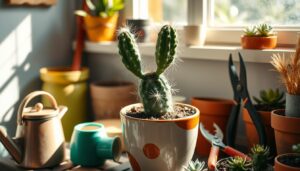

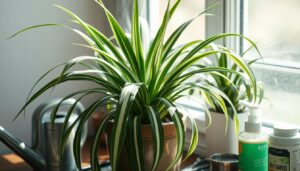
Pingback: Essential Ingredients for Cultivating an Indoor Garden – Growing Our Garden
Pingback: The Ultimate Guide to Houseplants: 100 Best Indoor Plants for Every Home - Trusted House Plant Guide
Pingback: ZZ Plant: The Ultimate Cold-Hardy, Low-Light Houseplant for Beginners
Pingback: Mini Monstera, The Trendy, Space-Saving Houseplant That Brings a Jungle Vibe Indoors
Pingback: Jewel Orchid (Ludisia discolor)
Pingback: Rainbow Eucalyptus Bonsai (Eucalyptus deglupta)
Pingback: ZZ Plant, The Nearly Indestructible Houseplant That Thrives on Neglect
Pingback: Zebra Plant, The Boldly Striped Succulent That’s Perfect for Low-Light Homes
Pingback: Chinese Money Plant, The Trendy, Humidity-Loving Houseplant You Need